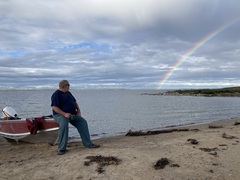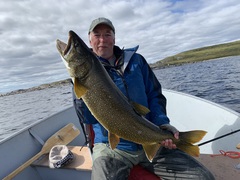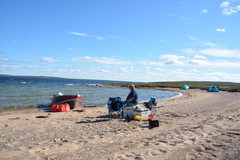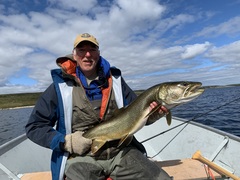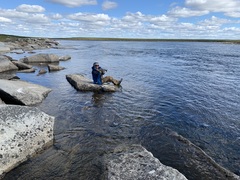Like many anglers, I dream of fishing remote, virginal waters, lakes where huge fish roam, never before having seen an artificial lure. Unfortunately, in today’s shrinking world this has become an increasingly unlikely proposition; there just aren’t many untouched waters left to explore. The exceptions, of course, are found in the Canadian Arctic, with literally thousands of lakes pockmarking the tundra that have never been fished. But getting to them can be a daunting, and hugely expensive, challenge. This past summer I found a crack in the system, and spent eight days exploring and fishing where few others have gone.
Kevin and Patti McNeil’s Aylmer Lake Lodge is fast becoming a popular destination for those seeking big lake trout and Arctic grayling. Located some 225 air miles northeast of Yellowknife, Aylmer saw little human activity until 2000, when a caribou lodge was built on the lake’s east end. With the closure of caribou hunting in 2005, the lodge was shuttered until 2012, when the McNeil’s took over. Previous to their ownership, there had been virtually no sportfishing on the 1700 sq. kms. of water, and there’s never been a commercial fishery there, nor a First Nations sustenance fishery. These are truly pristine waters, and in discussions with Kevin and one of his guides, I learned that lodge guests seldom venture more than an hour away - all the lakers and grayling they could want can be found without travelling far. That gave me an idea, and after a discussion with Kevin, he agreed to rent me and a friend, Dave Kay, a boat, motor and fuel, and let us explore Aylmer for eight days on our own. Did we find the virginal waters we’d dreamed of? Let’s just say that after leaving the lodge that first morning, we didn’t see another person or boat until we motored back into the lodge more than a week later!
Aylmer is a vast, remote and unspoiled lake that has seen very little fishing over the years.
For eight days we explored Aylmer’s unspoiled, historic, waters. In the 1830s, Sir George Back saw Aylmer Lake; the headwaters to the Back River, named in his honour, are a mere kilometre walk from the north end of Aylmer. Dave and I made that short trek one afternoon for no other reason than to be able to see the river and toss a few casts into her untarnished waters.
Then, in 1907, Ernest Thompson Seton, the prominent wildlife artist, author and co-founder of the Boy Scouts, led an expedition to the Northwest Territories and into Aylmer Lake, leaving a handful of cairns as the only sign he’d visited. Since Seton’s visit, few have traversed the lake, other than a handful of adventurous canoeists, the odd geologist, and McNeil’s team, so Dave and I were keen to be among the first anglers to explore it.
We went to Aylmer well-aware of its reputation for producing trophy-class lakers.
Well, man plans and God laughs. In what Kevin would later describe as, "The windiest week we’ve experienced since I bought the lodge," the weather did us no favours. Now, to be fair, we did have a couple days that weren’t bad, even one you would call sunny, but by and large the prevailing winds and cold impaired our ability to fish; we were even wind bound for two days in one of our camps. Despite that, whenever we did have a window of opportunity, we seized it. And, if you’re a half-full kind of person, the cold, wind and rain meant we weren’t having to deal with the mosquitoes and black flies that can, at times, make tundra life brutal.
Sandy beaches proved to be excellent camp sites.
As promised, Aylmer holds excellent numbers of large fish. We found them nearly everywhere we trolled large spoons or Bondy baits across windswept, rocky shorelines, usually in 10 to 20 feet of water. They were all healthy, averaging nearly 20 pounds, and lakers ranging up to 42 inches, fish in the 25- to 35-pound range, were plentiful. We actually had difficulty catching eating-sized lakers when we searched for fish in the five- to eight-pound class. Given that our fishing hours were severely limited by weather and travel, we were impressed with the frequency of hook-ups and the size of the fish we landed. No doubt, had the wind let up for any length of time, we’d have hooked lakers in excess of forty pounds, possibly into the fifties, as the records and photos show fish that size are in Aylmer.
When the winds abated, we caught healthy lake trout nearly everywhere we looked.
We camped each evening on a sandy shoreline and went for long walks to explore the tundra and check out incoming streams. Most of the moving waters held Arctic grayling. We’d hoped to fish extensively for grayling, and lake trout, with flies, but the near-constant wind made that difficult, so we threw small spinners to the grayling. One morning we ventured up the Lockhart River, the major inflow to Aylmer at the extreme west end. It’s a beautiful, tumbling river that held good numbers of large-sailed graying, and a surprising number of lakers, too.
The Lockhart River, at the extreme west end of Aylmer, is chock-full of nice Arctic grayling.
Exploring new water, especially in remote destinations, is about more than fish. The wildlife at Aylmer was spectacular, and over the course of our travels we saw musk-ox, caribou, Arctic wolves, foxes, and Arctic hares, siksiks (a large ground squirrel) and lemmings. We didn’t lay eyes on any of the barren-ground grizzly bears known to inhabit the area, though we saw their track, and we were fine with that! The bird life was equally impressive, and included long-tailed and pomarine jaegers, peregrine falcons, Arctic loons, long-tailed ducks, black scoters, bald eagles, and a host of other seabirds and shorebirds. When hiking the tundra, we’d frequently stop to feed on the plentiful blueberries, but unfortunately the cloudberries, a favourite of arctic travellers, weren’t yet ripe.
Shore lunch is always a highlight when fishing remote northern lakes.
I’ve had the opportunity to fish Arctic waters previously, including well-known lakes like Great Slave and Great Bear, but there’s nothing that equals the rewards of a do-it-yourself trip on such a huge expanse of water, learning the lake and the surrounding landscape as you go, with little risk of running into other people along the way. Anticipation and adventure are the hallmark of every fishing experience, and are never more real than when exploring a remote northern lake.

